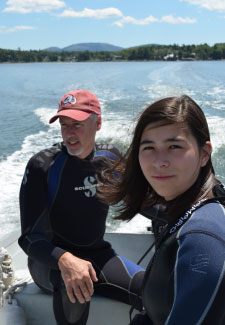Teaching science through both research and projects integrating cross-curricular principles and activities allows students to
apply relevance to learning. By finding real-world situations where students can ask their own questions, run their own
experiments, and make their own interpretations, they acquire the tools to develop and design solutions to problems.
The projects highlighted on this webpage exemplify my goal of bringing such real-world situations into the classroom.
Through connections made at the nearby University of Maine, organizations such as COSEE-Ocean Systems and NASA, and my own
grant writing initiatives, I strive to bring students closer to understanding and appreciating our need to construct knowledge
through science and design solutions through engineering and collaboration.
All of the projects that follow have roots in multiple scientific disciplines, often contain an engineering component, and
generally involve a theme that explores how humans interact with their environment. Projects explore everything from the water
and sediments of nearby estuaries to the air 100,000 feet above us. From the need to reduce what we throw away, to generating
green energy for vast populations not on the grid, students inquire and solve problems through hands-on research and
experimentation. Many present their findings in peer-reviewed publications or at science fairs because the communication of
results is a key component of science.
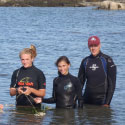 | |
In 2010, I helped develop a partnership between COSEE and Bangor High School whereby COSEE provided the funding for two teachers and four
students to participate in research opportunities at the Mount Desert Island Biological Laboratory (MDIBL). Funding was provided for three
summers (2010, 2011, 2012) at this world-class research facility. During this time, my students and I became part of a group involved in eelgrass restoration
in Frenchman Bay. In addition to the physical process of restoring eelgrass, we collected physical and chemical data from the water and
sediments to assess the overall environmental health of the Bay's ecosystem. The work we did during the summers carried over into the
classroom as students became involved in understanding such topics as ocean acidification and economic sustainability of natural resources.
I received a separate grant from MDIBL to bring Bangor High School students and a teacher to the Lab for a six-week research program in 2013. Our team
focussed primarily on the physical properties of sediments and the distribution of macro-invertebrates in the Bay.
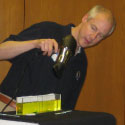 | |
Through my contacts with COSEE and their contract with NASA, I was selected to be a lead presenter at a NASA-based workshop designed to bring scientists and teachers together to discuss best practices for teaching ocean salinity concepts in the high school classroom. The driving force for this workshop was the imminent launch of NASA's new Aquarius satellite designed to collect comprehensive and continuous ocean surface salinity data. Part of the workshop was used to formulate ways in which to bring real-time salinity data into the classroom.
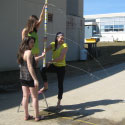 | |
Because of my work with COSEE, I was asked to prepare a webinar on how I teach ocean concepts to Earth Science students in high school. The webinar is a two-part series produced by COSEE as educational outreach to support NASA's Aquarius satellite. Using an inquiry approach, key ocean concepts are explored through identifying an array of physical properties that are influenced by dynamic mechanisms in both the atmosphere and oceans resulting in cause-and-effect relationships that drive climate change. The webinar includes photographs and video clips of students performing laboratories used to help construct their knowledge of the many integrated parameters that make the oceans such a dynamic system.
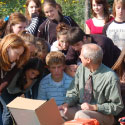 | |
Since 2006, I have received four grants from three organizations to fund the purchase of equipment to bring real science and engineering projects to my Chemistry, Earth Science, Environmental Studies, and STEM Research classes. A $10,000 Toyota TAPESTRY grant was used to purchase a seismograph to bring geophysics into our study of earthquakes and seismic energy. Toshiba America Foundation has awarded me two $5,000 grants: one to purchase vermi-composting equipment with which to study the science of turning refuse into valuable soil, and a second grant to purchase MudWatts® to investigate how electrical power can be generated through the natural decomposition of soil. A fourth grant was received from Target Inc. to take all of my Earth Science students on a field trip to Acadia National Park to explore geomorphic clues to Maine's glacial past.
 | |
Both my proximity to the University of Maine (UMaine) campus and contacts made through professional and educational outreach programs such as COSEE and Bangor High School's STEM Academy, have allowed me to develop relationships with UMaine researchers that include high levels of student participation and interaction. My Introduction to Research class in our STEM Academy has worked closely with UMaine's Electrical Engineering Department to send high-altitude balloons loaded with sensors and video equipment to analyze and model physical and chemical properties of the upper atmosphere. Contacts through COSEE have allowed several students and me to work with Dr. Lee Karp-Boss and other researchers from the Ocean Sciences Department on phytoplankton studies of freshwater lakes and saltwater estuaries. Both of these efforts provide ways to bring real-time and locally important data into the classroom.

